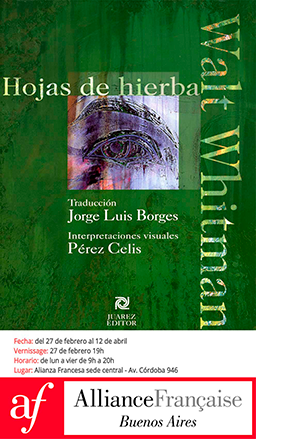ANA GALLARDO'S RECONSTRUCTION AND “DELIRIUM”
It could have been an ordinary retrospective, but the decision to participate in some way in the creative process is a differential and even declarative point in Tembló acá un delirio, the exhibition that Museo CA2M in Móstoles delves into the figure, and at first hand, of Ana Gallardo (Rosario, Argentina, 1958).
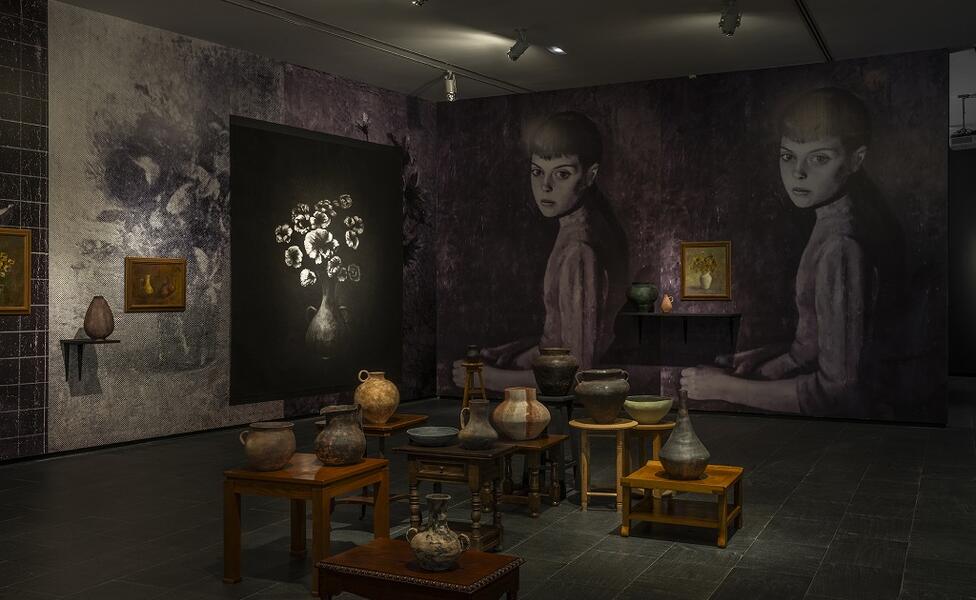
Curated by Alfredo Aracil and Violeta Janeiro, the layout and the proposal of the exhibition lead us to a materialization of the conceptual and the inertias with which the Argentinean artist debates. However, the visit to the galleries immerses the viewer in an even deeper and more enveloping subjectivity towards the processes of recovery and reconstruction.
Beyond the evident orientation of the pieces of the rosarina since decades working towards the denunciation of violence against women, the exploration of gender theories or the art system itself, it underlies an intention to address these issues through a language away from victimhood and that is generated around the dual antagonism of life and death and their meanings and that other repressive darkness that alludes to its management of oblivion. All this is concentrated in a journey that begins in an environment of installations with luminous and sonorous protagonism, until the visitor drifts towards a measured darkness, a reflection of that oblivion and, in general, of the struggles of disappearance and reconstruction of memory, but always with the fragile approach of avoiding any element that inflicts the legitimization of pain.
Already trapped in that black that decorates the interior rooms, Gallardo proposes, through the vital relationship with his mother and her experiences, a series of subjective conceptions, represented in the drawings based on the original paintings selected to build that path. His works thus trace this biography and its exhibition, where the portrait or psychoanalysis is explored as perhaps the most faithful representations of oneself, both externally and in the interior space. Supporting all this plastic option of (re)creation and the element of darkness, Tembló acá un delirio also wanders among documents and videos that invite us to export the intimacy of affliction to the terrain of the public and to perceive that disappearance and that suffering from other angles that social engineering has foreseen to cease to be so evident.
-
Vista de la instalación (II). Ana Gallardo (Cortesía Museo CA2M)
-
Vista de la instalación (II). Ana Gallardo (Cortesía Museo CA2M)
-
Vista de la instalación (III). Ana Gallardo (Cortesía Museo CA2M)
-
Vista de la instalación (IV). Ana Gallardo (Cortesía Museo CA2M)
-
Vista de la instalación. Ana Gallardo (Cortesía Museo CA2M)
Ana Gallardo. Tembló acá un delirio can be visited until July 7 at the CA2M Museum, Constitución 23, Móstoles, Spain.
Related Topics
May interest you

Tania Pardo (Madrid, Spain, 1976) is the new Director of the Museo Centro de Arte Dos de Mayo (CA2M Museum), the museum of contemporary art of the Community of Madrid. Pardo's career until her recent appointment has been built on a detailed work of promotion and visibility of emerging art through the curatorial actions she has developed in numerous Spanish institutions.
INTERVIEW WITH TANIA PARDO, NEW DIRECTOR OF CA2M MUSEUM
Tania Pardo (Madrid, Spain, 1976) is the new Director of the Museo Centro de Arte Dos de Mayo (CA2M Museum), the museum of contemporary art of the Community of Madrid. Pardo's career until her recent appointment has been built on a detailed work of promotion and visibility of emerging art through the curatorial actions she has developed in numerous Spanish institutions.

Tania Pardo (Madrid, Spain, 1976) is the new Director of the Museo Centro de Arte Dos de Mayo (CA2M Museum), the museum of contemporary art of the Community of Madrid. Pardo's career until her recent appointment has been built on a detailed work of promotion and visibility of emerging art through the curatorial actions she has developed in numerous Spanish institutions.
INTERVIEW WITH TANIA PARDO, NEW DIRECTOR OF CA2M MUSEUM
Tania Pardo (Madrid, Spain, 1976) is the new Director of the Museo Centro de Arte Dos de Mayo (CA2M Museum), the museum of contemporary art of the Community of Madrid. Pardo's career until her recent appointment has been built on a detailed work of promotion and visibility of emerging art through the curatorial actions she has developed in numerous Spanish institutions.

The CA2M (Museum Centro de Arte Dos de Mayo) presents the exhibition Ana Gallardo. Tembló acá un delirio. (A delirium trembled here). Curated by Alfredo Aracil and Violeta Janeiro, the show runs from March 2 to July 7, 2024.
ANA GALLARDO AT CA2M: RESISTANCE, GRIEF AND EMBODIMENT
The CA2M (Museum Centro de Arte Dos de Mayo) presents the exhibition Ana Gallardo. Tembló acá un delirio. (A delirium trembled here). Curated by Alfredo Aracil and Violeta Janeiro, the show runs from March 2 to July 7, 2024.
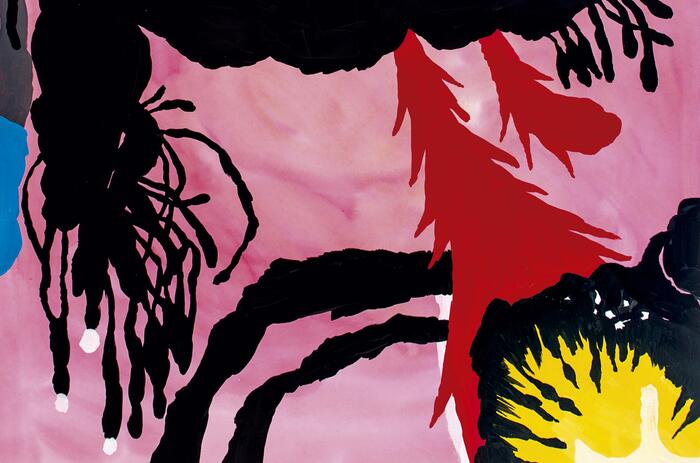
The Museo Extremeño e Iberoamericano de Arte Contemporáneo (MEIAC) in Badajoz is exhibiting, under the title Paisaje Transferido, a wide-ranging show by MartÍn Lopez Lam (Lima, Peru, 1981), one of the main exponents of graphic art in Spain, where he has been living for the last two decades.
MEIAC PRESENTS MARTÍN LÓPEZ LAM’S PAISAJE TRANSFERIDO
The Museo Extremeño e Iberoamericano de Arte Contemporáneo (MEIAC) in Badajoz is exhibiting, under the title Paisaje Transferido, a wide-ranging show by MartÍn Lopez Lam (Lima, Peru, 1981), one of the main exponents of graphic art in Spain, where he has been living for the last two decades.
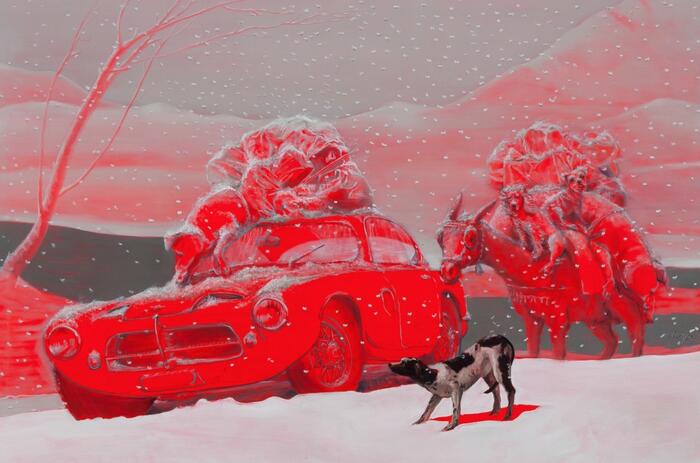
Alberto Baraya (Bogota, Colombia, 1968) lands through El Naturalista Artificial, his alter ego for the occasion, his working method to research and search, in an almost expeditionary way, the knowledge and exotic objects of the world in Fábulas Goyescas, recently inaugurated at Fernando Pradilla in Madrid.
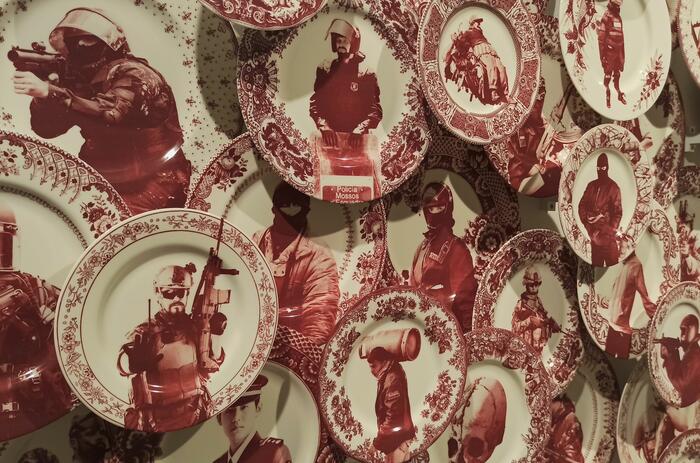
The Seville-based Fundación Valentín de Madariaga y Oya raises in its collective exhibition Herencia. Proyecto 360º the need to reconsider actions and return to the essential and almost primary link through the observation and analysis of our environment and its possibilities. The show gathers the work of fifteen international artists who become instrumental through their works for this purpose.
HERENCIA. PROYECTO 360º AND THE RECONSIDERATION OF OUR ACTIONS
The Seville-based Fundación Valentín de Madariaga y Oya raises in its collective exhibition Herencia. Proyecto 360º the need to reconsider actions and return to the essential and almost primary link through the observation and analysis of our environment and its possibilities. The show gathers the work of fifteen international artists who become instrumental through their works for this purpose.
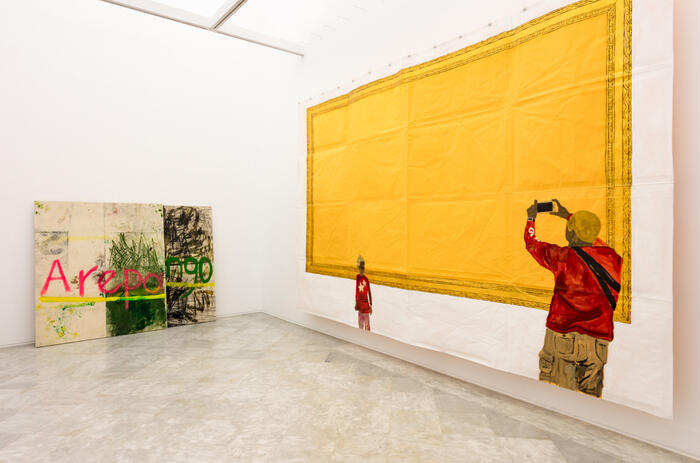
THE BALANCED REPRESENTATION OF LO LATINOAMERICANO IN THE JORGE M. PÉREZ COLLECTION

Héctor Canonge began to explore the possibilities of performance almost without being aware of it. With an extensive career in the field of new media and the art surrounding these technologies, and almost by inertia, he incorporates the use of his body in one of his installations, Schema CorpoReal, where his body covered by bar codes was scanned by the public so that, through texts that emerged referring to parts of his body, they ended up constructing a narrative of identity.
PERFORMANCE AND MYTH IN HECTOR CANONGE
Héctor Canonge began to explore the possibilities of performance almost without being aware of it. With an extensive career in the field of new media and the art surrounding these technologies, and almost by inertia, he incorporates the use of his body in one of his installations, Schema CorpoReal, where his body covered by bar codes was scanned by the public so that, through texts that emerged referring to parts of his body, they ended up constructing a narrative of identity.

Rosana Paulino. Amefricana is the most complete exhibition outside Brazil of this artist born in Sao Paulo in 1967. The exhibition at Malba brings together a group of works made during 30 years, between 1994 and 2024, from the perspective that the Atlantic inscribes in the Afro-descendant America.
AFFECTIVE POETICS: ROSANA PAULINO AT MALBA
Rosana Paulino. Amefricana is the most complete exhibition outside Brazil of this artist born in Sao Paulo in 1967. The exhibition at Malba brings together a group of works made during 30 years, between 1994 and 2024, from the perspective that the Atlantic inscribes in the Afro-descendant America.
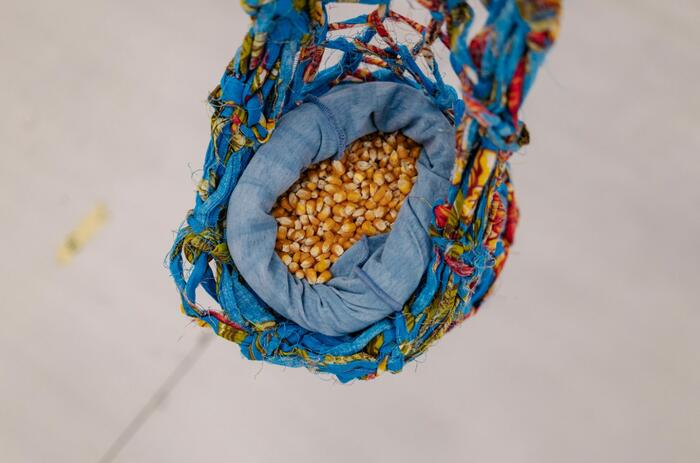
Ernesto Neto (Rio de Janeiro, Brazil, 1964) presents Nosso Barco Tambor Terra at Lisbon's Museum of Art, Architecture and Technology (MAAT), an impressive large-scale installation with which he evokes and stages the crossing of different cultures and the relationships between individuals from different continents.
ERNESTO NETO AND HIS CROSSROADS OF CULTURES AT MAAT
Ernesto Neto (Rio de Janeiro, Brazil, 1964) presents Nosso Barco Tambor Terra at Lisbon's Museum of Art, Architecture and Technology (MAAT), an impressive large-scale installation with which he evokes and stages the crossing of different cultures and the relationships between individuals from different continents.

Patricio Reig (San Juan, Argentina, 1952) exhibits at the Centre Cultural La Mercè in Girona Anatomía de la mirada, a proposal that deals with the dissection of the act of looking and its individual and subjective approach.
PATRICIO REIG AND THE ANATOMY OF THE GAZE
Patricio Reig (San Juan, Argentina, 1952) exhibits at the Centre Cultural La Mercè in Girona Anatomía de la mirada, a proposal that deals with the dissection of the act of looking and its individual and subjective approach.
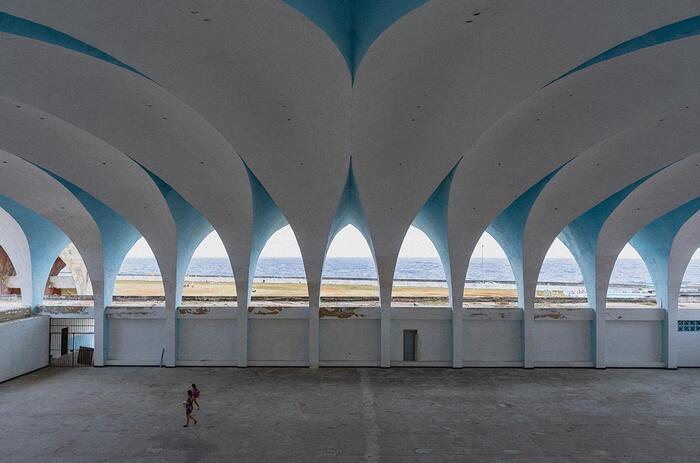
Included within the activities of the program Transcultura. Integrating Cuba, the Caribbean and the European Union through Culture and Creativity, an initiative coordinated by the European Union and implemented by UNESCO in Havana, fifteen young Caribbean photographers between the ages of 18 and 35 will participate in PHotoESPAÑA 2024 with the presentation of their recent work, in addition to being able to interact professionally with cultural agents and the sector.
YOUNG CARIBBEAN PHOTOGRAPHY AT PHOTOESPAÑA
Included within the activities of the program Transcultura. Integrating Cuba, the Caribbean and the European Union through Culture and Creativity, an initiative coordinated by the European Union and implemented by UNESCO in Havana, fifteen young Caribbean photographers between the ages of 18 and 35 will participate in PHotoESPAÑA 2024 with the presentation of their recent work, in addition to being able to interact professionally with cultural agents and the sector.
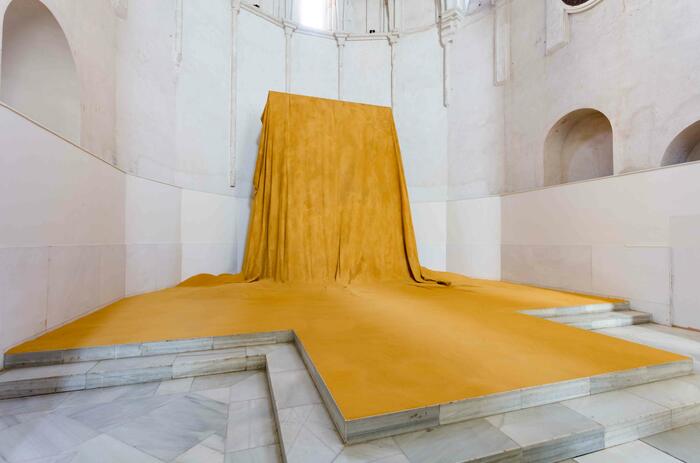
Delcy Morelos (Tierralta, Colombia, 1967) lands at the Centro Andaluz de Arte Contemporáneo (CAAC) in Seville with Profundis, an exhibition that gathers the spectacular intervention she has made ex profeso in the monumental areas of the Sevillian institution and that focuses on revitalizing the ancestral link of man with the earth, as well as capturing, through botany, the symbolism of the relations between Europe and America.
THE GERMINATION OF HISTORY ACCORDING TO DELCY MORELOS, IN SEVILLE
Delcy Morelos (Tierralta, Colombia, 1967) lands at the Centro Andaluz de Arte Contemporáneo (CAAC) in Seville with Profundis, an exhibition that gathers the spectacular intervention she has made ex profeso in the monumental areas of the Sevillian institution and that focuses on revitalizing the ancestral link of man with the earth, as well as capturing, through botany, the symbolism of the relations between Europe and America.
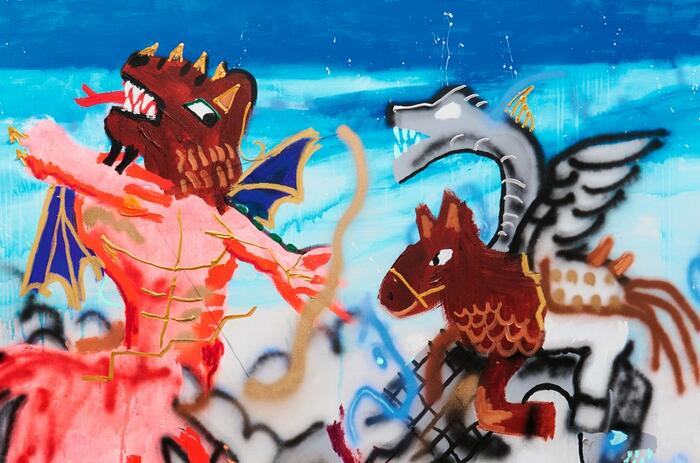
Standing before the expressive forcefulness of Mexican-American Robert Nava (East Chicago, USA, 1985) can be risky. At first glance, the primitivism in the technique used in his canvases is shocking in the conversion of the strength of the stroke and the basics of the gesture into a language that agglutinates a brute force. Perhaps for that reason, the usual tendency of those who face his work is to quickly pigeonhole it out of the academic, out of that refinement that is presupposed -although less and less- to those who fill the room of a museum, to let themselves be carried away by the urgency of expression in front of that pretended good taste.
THE URGENT BESTIARY OF ROBERT NAVA
Standing before the expressive forcefulness of Mexican-American Robert Nava (East Chicago, USA, 1985) can be risky. At first glance, the primitivism in the technique used in his canvases is shocking in the conversion of the strength of the stroke and the basics of the gesture into a language that agglutinates a brute force. Perhaps for that reason, the usual tendency of those who face his work is to quickly pigeonhole it out of the academic, out of that refinement that is presupposed -although less and less- to those who fill the room of a museum, to let themselves be carried away by the urgency of expression in front of that pretended good taste.
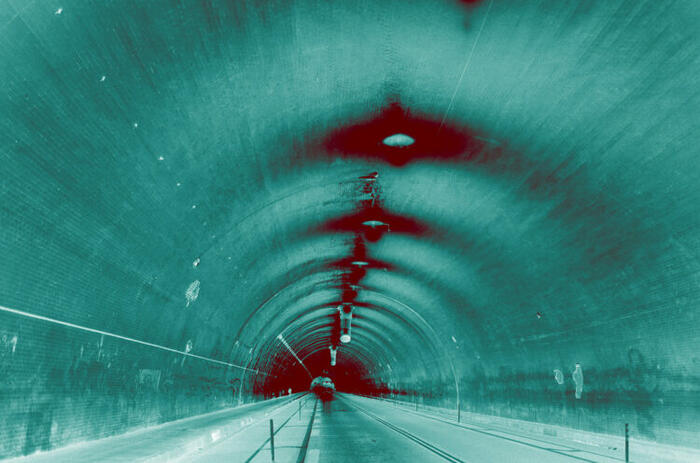
The Green Havana project is a captured sample of a time and an attitude, the same one that transits between evasion and hedonism and the social reality of the Cuban capital, a unique and referential site of that almost isolated Cuba and of a popular culture grown in the shadow of political influences.
LEANDRO FEAL AND HIS GREEN HAVANA
The Green Havana project is a captured sample of a time and an attitude, the same one that transits between evasion and hedonism and the social reality of the Cuban capital, a unique and referential site of that almost isolated Cuba and of a popular culture grown in the shadow of political influences.

Tania Pardo (Madrid, Spain, 1976) is the new Director of the Museo Centro de Arte Dos de Mayo (CA2M Museum), the museum of contemporary art of the Community of Madrid. Pardo's career until her recent appointment has been built on a detailed work of promotion and visibility of emerging art through the curatorial actions she has developed in numerous Spanish institutions.
INTERVIEW WITH TANIA PARDO, NEW DIRECTOR OF CA2M MUSEUM
Tania Pardo (Madrid, Spain, 1976) is the new Director of the Museo Centro de Arte Dos de Mayo (CA2M Museum), the museum of contemporary art of the Community of Madrid. Pardo's career until her recent appointment has been built on a detailed work of promotion and visibility of emerging art through the curatorial actions she has developed in numerous Spanish institutions.

The CA2M (Museum Centro de Arte Dos de Mayo) presents the exhibition Ana Gallardo. Tembló acá un delirio. (A delirium trembled here). Curated by Alfredo Aracil and Violeta Janeiro, the show runs from March 2 to July 7, 2024.
ANA GALLARDO AT CA2M: RESISTANCE, GRIEF AND EMBODIMENT
The CA2M (Museum Centro de Arte Dos de Mayo) presents the exhibition Ana Gallardo. Tembló acá un delirio. (A delirium trembled here). Curated by Alfredo Aracil and Violeta Janeiro, the show runs from March 2 to July 7, 2024.

The Museo Extremeño e Iberoamericano de Arte Contemporáneo (MEIAC) in Badajoz is exhibiting, under the title Paisaje Transferido, a wide-ranging show by MartÍn Lopez Lam (Lima, Peru, 1981), one of the main exponents of graphic art in Spain, where he has been living for the last two decades.
MEIAC PRESENTS MARTÍN LÓPEZ LAM’S PAISAJE TRANSFERIDO
The Museo Extremeño e Iberoamericano de Arte Contemporáneo (MEIAC) in Badajoz is exhibiting, under the title Paisaje Transferido, a wide-ranging show by MartÍn Lopez Lam (Lima, Peru, 1981), one of the main exponents of graphic art in Spain, where he has been living for the last two decades.

Alberto Baraya (Bogota, Colombia, 1968) lands through El Naturalista Artificial, his alter ego for the occasion, his working method to research and search, in an almost expeditionary way, the knowledge and exotic objects of the world in Fábulas Goyescas, recently inaugurated at Fernando Pradilla in Madrid.

The Seville-based Fundación Valentín de Madariaga y Oya raises in its collective exhibition Herencia. Proyecto 360º the need to reconsider actions and return to the essential and almost primary link through the observation and analysis of our environment and its possibilities. The show gathers the work of fifteen international artists who become instrumental through their works for this purpose.
HERENCIA. PROYECTO 360º AND THE RECONSIDERATION OF OUR ACTIONS
The Seville-based Fundación Valentín de Madariaga y Oya raises in its collective exhibition Herencia. Proyecto 360º the need to reconsider actions and return to the essential and almost primary link through the observation and analysis of our environment and its possibilities. The show gathers the work of fifteen international artists who become instrumental through their works for this purpose.

THE BALANCED REPRESENTATION OF LO LATINOAMERICANO IN THE JORGE M. PÉREZ COLLECTION

Héctor Canonge began to explore the possibilities of performance almost without being aware of it. With an extensive career in the field of new media and the art surrounding these technologies, and almost by inertia, he incorporates the use of his body in one of his installations, Schema CorpoReal, where his body covered by bar codes was scanned by the public so that, through texts that emerged referring to parts of his body, they ended up constructing a narrative of identity.
PERFORMANCE AND MYTH IN HECTOR CANONGE
Héctor Canonge began to explore the possibilities of performance almost without being aware of it. With an extensive career in the field of new media and the art surrounding these technologies, and almost by inertia, he incorporates the use of his body in one of his installations, Schema CorpoReal, where his body covered by bar codes was scanned by the public so that, through texts that emerged referring to parts of his body, they ended up constructing a narrative of identity.

Rosana Paulino. Amefricana is the most complete exhibition outside Brazil of this artist born in Sao Paulo in 1967. The exhibition at Malba brings together a group of works made during 30 years, between 1994 and 2024, from the perspective that the Atlantic inscribes in the Afro-descendant America.
AFFECTIVE POETICS: ROSANA PAULINO AT MALBA
Rosana Paulino. Amefricana is the most complete exhibition outside Brazil of this artist born in Sao Paulo in 1967. The exhibition at Malba brings together a group of works made during 30 years, between 1994 and 2024, from the perspective that the Atlantic inscribes in the Afro-descendant America.

Ernesto Neto (Rio de Janeiro, Brazil, 1964) presents Nosso Barco Tambor Terra at Lisbon's Museum of Art, Architecture and Technology (MAAT), an impressive large-scale installation with which he evokes and stages the crossing of different cultures and the relationships between individuals from different continents.
ERNESTO NETO AND HIS CROSSROADS OF CULTURES AT MAAT
Ernesto Neto (Rio de Janeiro, Brazil, 1964) presents Nosso Barco Tambor Terra at Lisbon's Museum of Art, Architecture and Technology (MAAT), an impressive large-scale installation with which he evokes and stages the crossing of different cultures and the relationships between individuals from different continents.

Patricio Reig (San Juan, Argentina, 1952) exhibits at the Centre Cultural La Mercè in Girona Anatomía de la mirada, a proposal that deals with the dissection of the act of looking and its individual and subjective approach.
PATRICIO REIG AND THE ANATOMY OF THE GAZE
Patricio Reig (San Juan, Argentina, 1952) exhibits at the Centre Cultural La Mercè in Girona Anatomía de la mirada, a proposal that deals with the dissection of the act of looking and its individual and subjective approach.

Included within the activities of the program Transcultura. Integrating Cuba, the Caribbean and the European Union through Culture and Creativity, an initiative coordinated by the European Union and implemented by UNESCO in Havana, fifteen young Caribbean photographers between the ages of 18 and 35 will participate in PHotoESPAÑA 2024 with the presentation of their recent work, in addition to being able to interact professionally with cultural agents and the sector.
YOUNG CARIBBEAN PHOTOGRAPHY AT PHOTOESPAÑA
Included within the activities of the program Transcultura. Integrating Cuba, the Caribbean and the European Union through Culture and Creativity, an initiative coordinated by the European Union and implemented by UNESCO in Havana, fifteen young Caribbean photographers between the ages of 18 and 35 will participate in PHotoESPAÑA 2024 with the presentation of their recent work, in addition to being able to interact professionally with cultural agents and the sector.

Delcy Morelos (Tierralta, Colombia, 1967) lands at the Centro Andaluz de Arte Contemporáneo (CAAC) in Seville with Profundis, an exhibition that gathers the spectacular intervention she has made ex profeso in the monumental areas of the Sevillian institution and that focuses on revitalizing the ancestral link of man with the earth, as well as capturing, through botany, the symbolism of the relations between Europe and America.
THE GERMINATION OF HISTORY ACCORDING TO DELCY MORELOS, IN SEVILLE
Delcy Morelos (Tierralta, Colombia, 1967) lands at the Centro Andaluz de Arte Contemporáneo (CAAC) in Seville with Profundis, an exhibition that gathers the spectacular intervention she has made ex profeso in the monumental areas of the Sevillian institution and that focuses on revitalizing the ancestral link of man with the earth, as well as capturing, through botany, the symbolism of the relations between Europe and America.

Standing before the expressive forcefulness of Mexican-American Robert Nava (East Chicago, USA, 1985) can be risky. At first glance, the primitivism in the technique used in his canvases is shocking in the conversion of the strength of the stroke and the basics of the gesture into a language that agglutinates a brute force. Perhaps for that reason, the usual tendency of those who face his work is to quickly pigeonhole it out of the academic, out of that refinement that is presupposed -although less and less- to those who fill the room of a museum, to let themselves be carried away by the urgency of expression in front of that pretended good taste.
THE URGENT BESTIARY OF ROBERT NAVA
Standing before the expressive forcefulness of Mexican-American Robert Nava (East Chicago, USA, 1985) can be risky. At first glance, the primitivism in the technique used in his canvases is shocking in the conversion of the strength of the stroke and the basics of the gesture into a language that agglutinates a brute force. Perhaps for that reason, the usual tendency of those who face his work is to quickly pigeonhole it out of the academic, out of that refinement that is presupposed -although less and less- to those who fill the room of a museum, to let themselves be carried away by the urgency of expression in front of that pretended good taste.

The Green Havana project is a captured sample of a time and an attitude, the same one that transits between evasion and hedonism and the social reality of the Cuban capital, a unique and referential site of that almost isolated Cuba and of a popular culture grown in the shadow of political influences.
LEANDRO FEAL AND HIS GREEN HAVANA
The Green Havana project is a captured sample of a time and an attitude, the same one that transits between evasion and hedonism and the social reality of the Cuban capital, a unique and referential site of that almost isolated Cuba and of a popular culture grown in the shadow of political influences.

Tania Pardo (Madrid, Spain, 1976) is the new Director of the Museo Centro de Arte Dos de Mayo (CA2M Museum), the museum of contemporary art of the Community of Madrid. Pardo's career until her recent appointment has been built on a detailed work of promotion and visibility of emerging art through the curatorial actions she has developed in numerous Spanish institutions.
INTERVIEW WITH TANIA PARDO, NEW DIRECTOR OF CA2M MUSEUM
Tania Pardo (Madrid, Spain, 1976) is the new Director of the Museo Centro de Arte Dos de Mayo (CA2M Museum), the museum of contemporary art of the Community of Madrid. Pardo's career until her recent appointment has been built on a detailed work of promotion and visibility of emerging art through the curatorial actions she has developed in numerous Spanish institutions.

The CA2M (Museum Centro de Arte Dos de Mayo) presents the exhibition Ana Gallardo. Tembló acá un delirio. (A delirium trembled here). Curated by Alfredo Aracil and Violeta Janeiro, the show runs from March 2 to July 7, 2024.
ANA GALLARDO AT CA2M: RESISTANCE, GRIEF AND EMBODIMENT
The CA2M (Museum Centro de Arte Dos de Mayo) presents the exhibition Ana Gallardo. Tembló acá un delirio. (A delirium trembled here). Curated by Alfredo Aracil and Violeta Janeiro, the show runs from March 2 to July 7, 2024.

The Museo Extremeño e Iberoamericano de Arte Contemporáneo (MEIAC) in Badajoz is exhibiting, under the title Paisaje Transferido, a wide-ranging show by MartÍn Lopez Lam (Lima, Peru, 1981), one of the main exponents of graphic art in Spain, where he has been living for the last two decades.
MEIAC PRESENTS MARTÍN LÓPEZ LAM’S PAISAJE TRANSFERIDO
The Museo Extremeño e Iberoamericano de Arte Contemporáneo (MEIAC) in Badajoz is exhibiting, under the title Paisaje Transferido, a wide-ranging show by MartÍn Lopez Lam (Lima, Peru, 1981), one of the main exponents of graphic art in Spain, where he has been living for the last two decades.

Alberto Baraya (Bogota, Colombia, 1968) lands through El Naturalista Artificial, his alter ego for the occasion, his working method to research and search, in an almost expeditionary way, the knowledge and exotic objects of the world in Fábulas Goyescas, recently inaugurated at Fernando Pradilla in Madrid.

The Seville-based Fundación Valentín de Madariaga y Oya raises in its collective exhibition Herencia. Proyecto 360º the need to reconsider actions and return to the essential and almost primary link through the observation and analysis of our environment and its possibilities. The show gathers the work of fifteen international artists who become instrumental through their works for this purpose.
HERENCIA. PROYECTO 360º AND THE RECONSIDERATION OF OUR ACTIONS
The Seville-based Fundación Valentín de Madariaga y Oya raises in its collective exhibition Herencia. Proyecto 360º the need to reconsider actions and return to the essential and almost primary link through the observation and analysis of our environment and its possibilities. The show gathers the work of fifteen international artists who become instrumental through their works for this purpose.

THE BALANCED REPRESENTATION OF LO LATINOAMERICANO IN THE JORGE M. PÉREZ COLLECTION

Héctor Canonge began to explore the possibilities of performance almost without being aware of it. With an extensive career in the field of new media and the art surrounding these technologies, and almost by inertia, he incorporates the use of his body in one of his installations, Schema CorpoReal, where his body covered by bar codes was scanned by the public so that, through texts that emerged referring to parts of his body, they ended up constructing a narrative of identity.
PERFORMANCE AND MYTH IN HECTOR CANONGE
Héctor Canonge began to explore the possibilities of performance almost without being aware of it. With an extensive career in the field of new media and the art surrounding these technologies, and almost by inertia, he incorporates the use of his body in one of his installations, Schema CorpoReal, where his body covered by bar codes was scanned by the public so that, through texts that emerged referring to parts of his body, they ended up constructing a narrative of identity.

Rosana Paulino. Amefricana is the most complete exhibition outside Brazil of this artist born in Sao Paulo in 1967. The exhibition at Malba brings together a group of works made during 30 years, between 1994 and 2024, from the perspective that the Atlantic inscribes in the Afro-descendant America.
AFFECTIVE POETICS: ROSANA PAULINO AT MALBA
Rosana Paulino. Amefricana is the most complete exhibition outside Brazil of this artist born in Sao Paulo in 1967. The exhibition at Malba brings together a group of works made during 30 years, between 1994 and 2024, from the perspective that the Atlantic inscribes in the Afro-descendant America.

Ernesto Neto (Rio de Janeiro, Brazil, 1964) presents Nosso Barco Tambor Terra at Lisbon's Museum of Art, Architecture and Technology (MAAT), an impressive large-scale installation with which he evokes and stages the crossing of different cultures and the relationships between individuals from different continents.
ERNESTO NETO AND HIS CROSSROADS OF CULTURES AT MAAT
Ernesto Neto (Rio de Janeiro, Brazil, 1964) presents Nosso Barco Tambor Terra at Lisbon's Museum of Art, Architecture and Technology (MAAT), an impressive large-scale installation with which he evokes and stages the crossing of different cultures and the relationships between individuals from different continents.

Patricio Reig (San Juan, Argentina, 1952) exhibits at the Centre Cultural La Mercè in Girona Anatomía de la mirada, a proposal that deals with the dissection of the act of looking and its individual and subjective approach.
PATRICIO REIG AND THE ANATOMY OF THE GAZE
Patricio Reig (San Juan, Argentina, 1952) exhibits at the Centre Cultural La Mercè in Girona Anatomía de la mirada, a proposal that deals with the dissection of the act of looking and its individual and subjective approach.

Included within the activities of the program Transcultura. Integrating Cuba, the Caribbean and the European Union through Culture and Creativity, an initiative coordinated by the European Union and implemented by UNESCO in Havana, fifteen young Caribbean photographers between the ages of 18 and 35 will participate in PHotoESPAÑA 2024 with the presentation of their recent work, in addition to being able to interact professionally with cultural agents and the sector.
YOUNG CARIBBEAN PHOTOGRAPHY AT PHOTOESPAÑA
Included within the activities of the program Transcultura. Integrating Cuba, the Caribbean and the European Union through Culture and Creativity, an initiative coordinated by the European Union and implemented by UNESCO in Havana, fifteen young Caribbean photographers between the ages of 18 and 35 will participate in PHotoESPAÑA 2024 with the presentation of their recent work, in addition to being able to interact professionally with cultural agents and the sector.

Delcy Morelos (Tierralta, Colombia, 1967) lands at the Centro Andaluz de Arte Contemporáneo (CAAC) in Seville with Profundis, an exhibition that gathers the spectacular intervention she has made ex profeso in the monumental areas of the Sevillian institution and that focuses on revitalizing the ancestral link of man with the earth, as well as capturing, through botany, the symbolism of the relations between Europe and America.
THE GERMINATION OF HISTORY ACCORDING TO DELCY MORELOS, IN SEVILLE
Delcy Morelos (Tierralta, Colombia, 1967) lands at the Centro Andaluz de Arte Contemporáneo (CAAC) in Seville with Profundis, an exhibition that gathers the spectacular intervention she has made ex profeso in the monumental areas of the Sevillian institution and that focuses on revitalizing the ancestral link of man with the earth, as well as capturing, through botany, the symbolism of the relations between Europe and America.

Standing before the expressive forcefulness of Mexican-American Robert Nava (East Chicago, USA, 1985) can be risky. At first glance, the primitivism in the technique used in his canvases is shocking in the conversion of the strength of the stroke and the basics of the gesture into a language that agglutinates a brute force. Perhaps for that reason, the usual tendency of those who face his work is to quickly pigeonhole it out of the academic, out of that refinement that is presupposed -although less and less- to those who fill the room of a museum, to let themselves be carried away by the urgency of expression in front of that pretended good taste.
THE URGENT BESTIARY OF ROBERT NAVA
Standing before the expressive forcefulness of Mexican-American Robert Nava (East Chicago, USA, 1985) can be risky. At first glance, the primitivism in the technique used in his canvases is shocking in the conversion of the strength of the stroke and the basics of the gesture into a language that agglutinates a brute force. Perhaps for that reason, the usual tendency of those who face his work is to quickly pigeonhole it out of the academic, out of that refinement that is presupposed -although less and less- to those who fill the room of a museum, to let themselves be carried away by the urgency of expression in front of that pretended good taste.

The Green Havana project is a captured sample of a time and an attitude, the same one that transits between evasion and hedonism and the social reality of the Cuban capital, a unique and referential site of that almost isolated Cuba and of a popular culture grown in the shadow of political influences.
LEANDRO FEAL AND HIS GREEN HAVANA
The Green Havana project is a captured sample of a time and an attitude, the same one that transits between evasion and hedonism and the social reality of the Cuban capital, a unique and referential site of that almost isolated Cuba and of a popular culture grown in the shadow of political influences.

Tania Pardo (Madrid, Spain, 1976) is the new Director of the Museo Centro de Arte Dos de Mayo (CA2M Museum), the museum of contemporary art of the Community of Madrid. Pardo's career until her recent appointment has been built on a detailed work of promotion and visibility of emerging art through the curatorial actions she has developed in numerous Spanish institutions.
INTERVIEW WITH TANIA PARDO, NEW DIRECTOR OF CA2M MUSEUM
Tania Pardo (Madrid, Spain, 1976) is the new Director of the Museo Centro de Arte Dos de Mayo (CA2M Museum), the museum of contemporary art of the Community of Madrid. Pardo's career until her recent appointment has been built on a detailed work of promotion and visibility of emerging art through the curatorial actions she has developed in numerous Spanish institutions.

The CA2M (Museum Centro de Arte Dos de Mayo) presents the exhibition Ana Gallardo. Tembló acá un delirio. (A delirium trembled here). Curated by Alfredo Aracil and Violeta Janeiro, the show runs from March 2 to July 7, 2024.
ANA GALLARDO AT CA2M: RESISTANCE, GRIEF AND EMBODIMENT
The CA2M (Museum Centro de Arte Dos de Mayo) presents the exhibition Ana Gallardo. Tembló acá un delirio. (A delirium trembled here). Curated by Alfredo Aracil and Violeta Janeiro, the show runs from March 2 to July 7, 2024.

The Museo Extremeño e Iberoamericano de Arte Contemporáneo (MEIAC) in Badajoz is exhibiting, under the title Paisaje Transferido, a wide-ranging show by MartÍn Lopez Lam (Lima, Peru, 1981), one of the main exponents of graphic art in Spain, where he has been living for the last two decades.
MEIAC PRESENTS MARTÍN LÓPEZ LAM’S PAISAJE TRANSFERIDO
The Museo Extremeño e Iberoamericano de Arte Contemporáneo (MEIAC) in Badajoz is exhibiting, under the title Paisaje Transferido, a wide-ranging show by MartÍn Lopez Lam (Lima, Peru, 1981), one of the main exponents of graphic art in Spain, where he has been living for the last two decades.

Alberto Baraya (Bogota, Colombia, 1968) lands through El Naturalista Artificial, his alter ego for the occasion, his working method to research and search, in an almost expeditionary way, the knowledge and exotic objects of the world in Fábulas Goyescas, recently inaugurated at Fernando Pradilla in Madrid.

The Seville-based Fundación Valentín de Madariaga y Oya raises in its collective exhibition Herencia. Proyecto 360º the need to reconsider actions and return to the essential and almost primary link through the observation and analysis of our environment and its possibilities. The show gathers the work of fifteen international artists who become instrumental through their works for this purpose.
HERENCIA. PROYECTO 360º AND THE RECONSIDERATION OF OUR ACTIONS
The Seville-based Fundación Valentín de Madariaga y Oya raises in its collective exhibition Herencia. Proyecto 360º the need to reconsider actions and return to the essential and almost primary link through the observation and analysis of our environment and its possibilities. The show gathers the work of fifteen international artists who become instrumental through their works for this purpose.

THE BALANCED REPRESENTATION OF LO LATINOAMERICANO IN THE JORGE M. PÉREZ COLLECTION

Héctor Canonge began to explore the possibilities of performance almost without being aware of it. With an extensive career in the field of new media and the art surrounding these technologies, and almost by inertia, he incorporates the use of his body in one of his installations, Schema CorpoReal, where his body covered by bar codes was scanned by the public so that, through texts that emerged referring to parts of his body, they ended up constructing a narrative of identity.
PERFORMANCE AND MYTH IN HECTOR CANONGE
Héctor Canonge began to explore the possibilities of performance almost without being aware of it. With an extensive career in the field of new media and the art surrounding these technologies, and almost by inertia, he incorporates the use of his body in one of his installations, Schema CorpoReal, where his body covered by bar codes was scanned by the public so that, through texts that emerged referring to parts of his body, they ended up constructing a narrative of identity.

Rosana Paulino. Amefricana is the most complete exhibition outside Brazil of this artist born in Sao Paulo in 1967. The exhibition at Malba brings together a group of works made during 30 years, between 1994 and 2024, from the perspective that the Atlantic inscribes in the Afro-descendant America.
AFFECTIVE POETICS: ROSANA PAULINO AT MALBA
Rosana Paulino. Amefricana is the most complete exhibition outside Brazil of this artist born in Sao Paulo in 1967. The exhibition at Malba brings together a group of works made during 30 years, between 1994 and 2024, from the perspective that the Atlantic inscribes in the Afro-descendant America.

Ernesto Neto (Rio de Janeiro, Brazil, 1964) presents Nosso Barco Tambor Terra at Lisbon's Museum of Art, Architecture and Technology (MAAT), an impressive large-scale installation with which he evokes and stages the crossing of different cultures and the relationships between individuals from different continents.
ERNESTO NETO AND HIS CROSSROADS OF CULTURES AT MAAT
Ernesto Neto (Rio de Janeiro, Brazil, 1964) presents Nosso Barco Tambor Terra at Lisbon's Museum of Art, Architecture and Technology (MAAT), an impressive large-scale installation with which he evokes and stages the crossing of different cultures and the relationships between individuals from different continents.

Patricio Reig (San Juan, Argentina, 1952) exhibits at the Centre Cultural La Mercè in Girona Anatomía de la mirada, a proposal that deals with the dissection of the act of looking and its individual and subjective approach.
PATRICIO REIG AND THE ANATOMY OF THE GAZE
Patricio Reig (San Juan, Argentina, 1952) exhibits at the Centre Cultural La Mercè in Girona Anatomía de la mirada, a proposal that deals with the dissection of the act of looking and its individual and subjective approach.

Included within the activities of the program Transcultura. Integrating Cuba, the Caribbean and the European Union through Culture and Creativity, an initiative coordinated by the European Union and implemented by UNESCO in Havana, fifteen young Caribbean photographers between the ages of 18 and 35 will participate in PHotoESPAÑA 2024 with the presentation of their recent work, in addition to being able to interact professionally with cultural agents and the sector.
YOUNG CARIBBEAN PHOTOGRAPHY AT PHOTOESPAÑA
Included within the activities of the program Transcultura. Integrating Cuba, the Caribbean and the European Union through Culture and Creativity, an initiative coordinated by the European Union and implemented by UNESCO in Havana, fifteen young Caribbean photographers between the ages of 18 and 35 will participate in PHotoESPAÑA 2024 with the presentation of their recent work, in addition to being able to interact professionally with cultural agents and the sector.

Delcy Morelos (Tierralta, Colombia, 1967) lands at the Centro Andaluz de Arte Contemporáneo (CAAC) in Seville with Profundis, an exhibition that gathers the spectacular intervention she has made ex profeso in the monumental areas of the Sevillian institution and that focuses on revitalizing the ancestral link of man with the earth, as well as capturing, through botany, the symbolism of the relations between Europe and America.
THE GERMINATION OF HISTORY ACCORDING TO DELCY MORELOS, IN SEVILLE
Delcy Morelos (Tierralta, Colombia, 1967) lands at the Centro Andaluz de Arte Contemporáneo (CAAC) in Seville with Profundis, an exhibition that gathers the spectacular intervention she has made ex profeso in the monumental areas of the Sevillian institution and that focuses on revitalizing the ancestral link of man with the earth, as well as capturing, through botany, the symbolism of the relations between Europe and America.

Standing before the expressive forcefulness of Mexican-American Robert Nava (East Chicago, USA, 1985) can be risky. At first glance, the primitivism in the technique used in his canvases is shocking in the conversion of the strength of the stroke and the basics of the gesture into a language that agglutinates a brute force. Perhaps for that reason, the usual tendency of those who face his work is to quickly pigeonhole it out of the academic, out of that refinement that is presupposed -although less and less- to those who fill the room of a museum, to let themselves be carried away by the urgency of expression in front of that pretended good taste.
THE URGENT BESTIARY OF ROBERT NAVA
Standing before the expressive forcefulness of Mexican-American Robert Nava (East Chicago, USA, 1985) can be risky. At first glance, the primitivism in the technique used in his canvases is shocking in the conversion of the strength of the stroke and the basics of the gesture into a language that agglutinates a brute force. Perhaps for that reason, the usual tendency of those who face his work is to quickly pigeonhole it out of the academic, out of that refinement that is presupposed -although less and less- to those who fill the room of a museum, to let themselves be carried away by the urgency of expression in front of that pretended good taste.

The Green Havana project is a captured sample of a time and an attitude, the same one that transits between evasion and hedonism and the social reality of the Cuban capital, a unique and referential site of that almost isolated Cuba and of a popular culture grown in the shadow of political influences.
LEANDRO FEAL AND HIS GREEN HAVANA
The Green Havana project is a captured sample of a time and an attitude, the same one that transits between evasion and hedonism and the social reality of the Cuban capital, a unique and referential site of that almost isolated Cuba and of a popular culture grown in the shadow of political influences.

Tania Pardo (Madrid, Spain, 1976) is the new Director of the Museo Centro de Arte Dos de Mayo (CA2M Museum), the museum of contemporary art of the Community of Madrid. Pardo's career until her recent appointment has been built on a detailed work of promotion and visibility of emerging art through the curatorial actions she has developed in numerous Spanish institutions.
INTERVIEW WITH TANIA PARDO, NEW DIRECTOR OF CA2M MUSEUM
Tania Pardo (Madrid, Spain, 1976) is the new Director of the Museo Centro de Arte Dos de Mayo (CA2M Museum), the museum of contemporary art of the Community of Madrid. Pardo's career until her recent appointment has been built on a detailed work of promotion and visibility of emerging art through the curatorial actions she has developed in numerous Spanish institutions.

The CA2M (Museum Centro de Arte Dos de Mayo) presents the exhibition Ana Gallardo. Tembló acá un delirio. (A delirium trembled here). Curated by Alfredo Aracil and Violeta Janeiro, the show runs from March 2 to July 7, 2024.
ANA GALLARDO AT CA2M: RESISTANCE, GRIEF AND EMBODIMENT
The CA2M (Museum Centro de Arte Dos de Mayo) presents the exhibition Ana Gallardo. Tembló acá un delirio. (A delirium trembled here). Curated by Alfredo Aracil and Violeta Janeiro, the show runs from March 2 to July 7, 2024.

The Museo Extremeño e Iberoamericano de Arte Contemporáneo (MEIAC) in Badajoz is exhibiting, under the title Paisaje Transferido, a wide-ranging show by MartÍn Lopez Lam (Lima, Peru, 1981), one of the main exponents of graphic art in Spain, where he has been living for the last two decades.
MEIAC PRESENTS MARTÍN LÓPEZ LAM’S PAISAJE TRANSFERIDO
The Museo Extremeño e Iberoamericano de Arte Contemporáneo (MEIAC) in Badajoz is exhibiting, under the title Paisaje Transferido, a wide-ranging show by MartÍn Lopez Lam (Lima, Peru, 1981), one of the main exponents of graphic art in Spain, where he has been living for the last two decades.

Alberto Baraya (Bogota, Colombia, 1968) lands through El Naturalista Artificial, his alter ego for the occasion, his working method to research and search, in an almost expeditionary way, the knowledge and exotic objects of the world in Fábulas Goyescas, recently inaugurated at Fernando Pradilla in Madrid.

The Seville-based Fundación Valentín de Madariaga y Oya raises in its collective exhibition Herencia. Proyecto 360º the need to reconsider actions and return to the essential and almost primary link through the observation and analysis of our environment and its possibilities. The show gathers the work of fifteen international artists who become instrumental through their works for this purpose.
HERENCIA. PROYECTO 360º AND THE RECONSIDERATION OF OUR ACTIONS
The Seville-based Fundación Valentín de Madariaga y Oya raises in its collective exhibition Herencia. Proyecto 360º the need to reconsider actions and return to the essential and almost primary link through the observation and analysis of our environment and its possibilities. The show gathers the work of fifteen international artists who become instrumental through their works for this purpose.

THE BALANCED REPRESENTATION OF LO LATINOAMERICANO IN THE JORGE M. PÉREZ COLLECTION

Héctor Canonge began to explore the possibilities of performance almost without being aware of it. With an extensive career in the field of new media and the art surrounding these technologies, and almost by inertia, he incorporates the use of his body in one of his installations, Schema CorpoReal, where his body covered by bar codes was scanned by the public so that, through texts that emerged referring to parts of his body, they ended up constructing a narrative of identity.
PERFORMANCE AND MYTH IN HECTOR CANONGE
Héctor Canonge began to explore the possibilities of performance almost without being aware of it. With an extensive career in the field of new media and the art surrounding these technologies, and almost by inertia, he incorporates the use of his body in one of his installations, Schema CorpoReal, where his body covered by bar codes was scanned by the public so that, through texts that emerged referring to parts of his body, they ended up constructing a narrative of identity.

Rosana Paulino. Amefricana is the most complete exhibition outside Brazil of this artist born in Sao Paulo in 1967. The exhibition at Malba brings together a group of works made during 30 years, between 1994 and 2024, from the perspective that the Atlantic inscribes in the Afro-descendant America.
AFFECTIVE POETICS: ROSANA PAULINO AT MALBA
Rosana Paulino. Amefricana is the most complete exhibition outside Brazil of this artist born in Sao Paulo in 1967. The exhibition at Malba brings together a group of works made during 30 years, between 1994 and 2024, from the perspective that the Atlantic inscribes in the Afro-descendant America.

Ernesto Neto (Rio de Janeiro, Brazil, 1964) presents Nosso Barco Tambor Terra at Lisbon's Museum of Art, Architecture and Technology (MAAT), an impressive large-scale installation with which he evokes and stages the crossing of different cultures and the relationships between individuals from different continents.
ERNESTO NETO AND HIS CROSSROADS OF CULTURES AT MAAT
Ernesto Neto (Rio de Janeiro, Brazil, 1964) presents Nosso Barco Tambor Terra at Lisbon's Museum of Art, Architecture and Technology (MAAT), an impressive large-scale installation with which he evokes and stages the crossing of different cultures and the relationships between individuals from different continents.

Patricio Reig (San Juan, Argentina, 1952) exhibits at the Centre Cultural La Mercè in Girona Anatomía de la mirada, a proposal that deals with the dissection of the act of looking and its individual and subjective approach.
PATRICIO REIG AND THE ANATOMY OF THE GAZE
Patricio Reig (San Juan, Argentina, 1952) exhibits at the Centre Cultural La Mercè in Girona Anatomía de la mirada, a proposal that deals with the dissection of the act of looking and its individual and subjective approach.

Included within the activities of the program Transcultura. Integrating Cuba, the Caribbean and the European Union through Culture and Creativity, an initiative coordinated by the European Union and implemented by UNESCO in Havana, fifteen young Caribbean photographers between the ages of 18 and 35 will participate in PHotoESPAÑA 2024 with the presentation of their recent work, in addition to being able to interact professionally with cultural agents and the sector.
YOUNG CARIBBEAN PHOTOGRAPHY AT PHOTOESPAÑA
Included within the activities of the program Transcultura. Integrating Cuba, the Caribbean and the European Union through Culture and Creativity, an initiative coordinated by the European Union and implemented by UNESCO in Havana, fifteen young Caribbean photographers between the ages of 18 and 35 will participate in PHotoESPAÑA 2024 with the presentation of their recent work, in addition to being able to interact professionally with cultural agents and the sector.

Delcy Morelos (Tierralta, Colombia, 1967) lands at the Centro Andaluz de Arte Contemporáneo (CAAC) in Seville with Profundis, an exhibition that gathers the spectacular intervention she has made ex profeso in the monumental areas of the Sevillian institution and that focuses on revitalizing the ancestral link of man with the earth, as well as capturing, through botany, the symbolism of the relations between Europe and America.
THE GERMINATION OF HISTORY ACCORDING TO DELCY MORELOS, IN SEVILLE
Delcy Morelos (Tierralta, Colombia, 1967) lands at the Centro Andaluz de Arte Contemporáneo (CAAC) in Seville with Profundis, an exhibition that gathers the spectacular intervention she has made ex profeso in the monumental areas of the Sevillian institution and that focuses on revitalizing the ancestral link of man with the earth, as well as capturing, through botany, the symbolism of the relations between Europe and America.

Standing before the expressive forcefulness of Mexican-American Robert Nava (East Chicago, USA, 1985) can be risky. At first glance, the primitivism in the technique used in his canvases is shocking in the conversion of the strength of the stroke and the basics of the gesture into a language that agglutinates a brute force. Perhaps for that reason, the usual tendency of those who face his work is to quickly pigeonhole it out of the academic, out of that refinement that is presupposed -although less and less- to those who fill the room of a museum, to let themselves be carried away by the urgency of expression in front of that pretended good taste.
THE URGENT BESTIARY OF ROBERT NAVA
Standing before the expressive forcefulness of Mexican-American Robert Nava (East Chicago, USA, 1985) can be risky. At first glance, the primitivism in the technique used in his canvases is shocking in the conversion of the strength of the stroke and the basics of the gesture into a language that agglutinates a brute force. Perhaps for that reason, the usual tendency of those who face his work is to quickly pigeonhole it out of the academic, out of that refinement that is presupposed -although less and less- to those who fill the room of a museum, to let themselves be carried away by the urgency of expression in front of that pretended good taste.

The Green Havana project is a captured sample of a time and an attitude, the same one that transits between evasion and hedonism and the social reality of the Cuban capital, a unique and referential site of that almost isolated Cuba and of a popular culture grown in the shadow of political influences.
LEANDRO FEAL AND HIS GREEN HAVANA
The Green Havana project is a captured sample of a time and an attitude, the same one that transits between evasion and hedonism and the social reality of the Cuban capital, a unique and referential site of that almost isolated Cuba and of a popular culture grown in the shadow of political influences.

